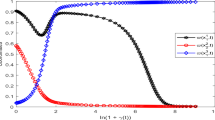Abstract
In a decentralized setting the game-theoretical predictions are that only strong blockings are allowed to rupture the structure of a matching. This paper argues that, under indifferences, also weak blockings should be considered when these blockings come from the grand coalition. This solution concept requires stability plus Pareto optimality. A characterization of the set of Pareto-stable matchings for the roommate and the marriage models is provided in terms of individually rational matchings whose blocking pairs, if any, are formed with unmatched agents. These matchings always exist and give an economic intuition on how blocking can be done by non-trading agents, so that the transactions need not be undone as agents reach the set of stable matchings. Some properties of the Pareto-stable matchings shared by the Marriage and Roommate models are obtained.
Similar content being viewed by others
References
Gale D, Shapley L (1962) College admissions and the stability of marriage. Am Math Mon 69: 9–15
Gale D, Sotomayor M (1985a) Some remarks on the stable matching problem. Discret Appl Math 11: 223–232
Gale D, Sotomayor M (1985b) Ms. Machiavelli and the stable matching problem. Am Math Mon 92: 261–268
Irving RW (1994) Stable marriage and indifference. Discret Appl Math 48: 261–272
Irving RW, Manlove DF, Scott S (2000) The hospitals/residents problem with ties. (Lecture notes in computer science), vol 1851. Springer, NY, pp 259–271
Knuth DE (1976) Marriages stables. Les Presses de L’Universite de Montreal, Montreal, QC
Manlove D (1999) Stable marriage with ties and unacceptable partners. Technical report TR-1999-29, University of Glasgow, Glasgow
McVitie DG, Wilson LB (1970) Stable marriage assignments for unequal sets. BIT 10: 295–309
Roth A, Sotomayor M (1990) Two-sided matching. A study in game-theoretic modeling and analysis, Econometric Society monographs, vol 18. 2. Cambridge University Press, Cambridge
Shapley L, Scarf H (1974) On cores and indivisibility. J Math Econ 1: 23–28
Shapley L, Shubik M (1972) The assignment game I: the core. J Game Theory 1: 111–130
Sotomayor M (1996) A non-constructive elementary proof of the existence of stable marriages. Game Econ Behav 13: 135–137
Sotomayor M (1999) Three remarks on the many-to-many stable matching problem. Math Soc Sci 38: 55–70
Sotomayor M (2000) Existence of stable outcomes and the lattice property for a unified matching market. Math Soc Sci 39: 119–132
Sotomayor M (2004) Implementation in the many to many matching market. Game Econ Behav 46: 199–212
Sotomayor M (2005) An elementary non-constructive proof of the non-emptiness of the core of the housing-market of Shapley and Scarf. Math Soc Sci 50: 298–303
Author information
Authors and Affiliations
Corresponding author
Rights and permissions
About this article
Cite this article
Sotomayor, M. The pareto-stability concept is a natural solution concept for discrete matching markets with indifferences. Int J Game Theory 40, 631–644 (2011). https://doi.org/10.1007/s00182-010-0259-1
Accepted:
Published:
Issue Date:
DOI: https://doi.org/10.1007/s00182-010-0259-1




